2013 News
Read past news stories from the School of Design Innovation's 2013 news archive.
On this page:
- Students update classic animation technique
- Victoria designers scoop Best Awards
- Wearable technology on show
- Cast design headed for international competition
- School of Design gets behind international conference
- International blog success for School of Design
- New cast design making waves online
- Victoria and Weta Digital power growth in Wellington
- Victoria Design School representation at the Maketorium
- Victoria students launch summer projects
- Victoria MDI student features on 3 News 'Tech Bytes'
- Pinokio gets staff pick on Vimeo
- Internet award for Tardigotchi
Victoria University holiday break
20 December

Victoria University is closed from 21 December 2013. We will reopen on Monday 6 January 2014. You can apply online any time.
Students update classic animation technique
29 November
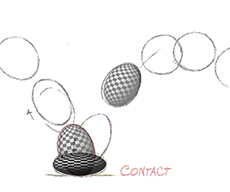
Computer Graphics students at Victoria University have created an efficient version of an animation technique used by studios including Disney and Pixar.
The work is the result of a collaborative project by Byron Mallett, a Master’s student in the School of Design and Richard Roberts, A PhD student in the School of Engineering and Computer Science, as part of Victoria’s interdisciplinary Computer Graphics Programme.
Byron and Richard have developed a new technique for the classic ‘squash and stretch’ convention, where the shape of a character or object is intentionally distorted to accentuate its movement.
The proposed alternative aims to overcome issues with current tools by automating much of the repetitive manual work, while maintaining complete customisability by the artist.
Richard says collaborating on the paper was a great experience. “Our different backgrounds and strengths meant we could each contribute a different perspective to the project.”
“Byron’s expertise in animation meant he could provide content to work with, as well as critique on the way the software worked for artists. My knowledge of programming allowed for fast iteration of the tool.”
Dr Rhazes Spell, lecturer of Media Design and Computer Graphics in the School of Design, says this sort of innovative work is a result of the Computer Graphics Programme’s unique beginnings.
“Students benefit from taking classes and conducting research in both schools and working with local industry. Wellington provides an ideal learning and research setting for this cutting edge programme,” he says.
Byron and Richard presented their paper, entitled A Pose Space for Squash and Stretch Deformation, at the 28th International Conference on Image and Vision Computing New Zealand, and the paper will be appearing in the IEEE digital library.
Find out more about the project.
Victoria designers scoop Best Awards
21 October
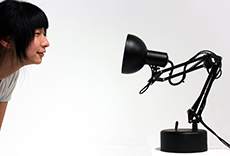
Innovative entries from Victoria University of Wellington architects and designers have won top prizes in the 2013 Best Design Awards.
An initiative of the Designers Institute of New Zealand, the Best Design Awards recognise outstanding New Zealand graphic, interactive, product and spatial design.
A cross-disciplinary team of Media and Industrial Design students from Victoria won gold in the Interactive category for their project, Pinokio Lamp.
Created by Adam Ben-Dror, Shanshan Zhou and Joss Doggett, the lamp interacts with its users by tracing their movements and responding to sounds, bringing to life an everyday, mundane object.
Design student Earl Stewart won silver in the Product Design category for his XYZ Shoe, designed from 3D scans of the foot. In collaboration with a podiatrist, the biomechanical performance is tailor made for the individual.
Margaret Petty, Head of the School of Design is delighted by the results of this year’s awards and says it’s fantastic to see Victoria University so well represented.
“We are particularly proud of the great showing by our Design students. Receiving national recognition for their projects is wonderful boost and a good reward for many long hours and sleepless nights,” she says.
Architecture students, Liam McRoberts and Samuel Skogstad scooped two awards in the Spatial Design category. Liam was awarded silver for his design The New Villa, and Samuel bronze for his design titled A Domestic Architecture of 'Solas'.
Victoria University staff members are also amongst the award winners. Sam Kebbell, a lecturer in the School of Architecture, received a silver award in the Spatial Design category for his design titled Resn's Office.
Bronze in the Spatial Design category was awarded to Simon Twose, Director of Postgraduate Programmes at the School of Architecture alongside Professor Andrew Barrie from the University of Auckland, for their design titled Familial Clouds: An exhibit at the Venice Architecture Biennale, 2012.
A Domestic Architecture of ‘Solas’
Familial Clouds: An exhibit at the Venice Architecture Biennale, 2012
Wearable technology on show
1 October
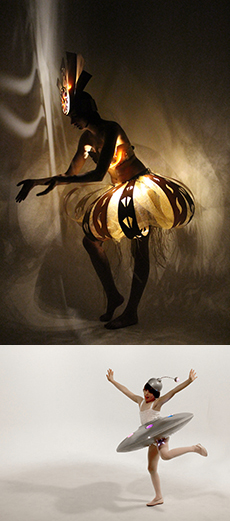
The runway of the 2013 World of Wearable Art show is alight with the latest advances in wearable technology from Victoria University of Wellington’s School of Design.
Anne Niemetz, a senior lecturer in Victoria’s Media Design programme, had her garment ‘Starship Pirouette’ selected for the Children’s section, where designers were challenged to re-interpret the ballet tutu.
‘Ura rā’, a garment inspired by the Cook Island dance costume and created by Rachel Hockin, a Master of Design Innovation student, was selected for the South Pacific section.
Both are first-time entrants of WOW. “I thought it was high time as a teacher of wearable technology to enter the competition,” says Niemetz.
Starship Pirouette was inspired by UFOs and features lights on the top, side and bottom of the garment.
“The speed of the light movement on the side is influenced by an accelerometer and there is a light ring at the bottom which slowly pulses,” says Niemetz.
“The initial concept had two antennas but when I refined the design, I thought it was too insectoid. One of my Master’s students recommended having one antenna because it’s more alien-like and absurd.”
Born and raised in Rarotonga, Hockin says she was inspired to design her wearable technology garment during a course taught by Niemetz last year. “I learned the technical skills with Anne, and then did an independent study over summer where I developed ‘Ura rā’.”
Translated as ‘sun dance’, each element of ‘Ura rā’ has a different meaning and was crafted by hand. The skirt represents the sea, the hat signifies the sky and the bra, the land. They all light up to represent the Gods of the Cook Islands.
To make the skirt, Hockin folded two types of veneer (very thin wood) into loops around the hips, referencing the titi (belt around the hips) from the Cook Island dance costume.
“The titi is the biggest part of the costume and emphasises the movement of the hips. The symbols are of waves and spearheads, meaning strength and power. This is the ‘wow’ factor of the costume,” she says.
In the head piece, LED lights sit behind strips of veneer which have stencilled patterns symbolising the sky. Much like the headpiece, veneer is stitched onto the bra and lights shine through hand-cut patterns. The main symbol used is the moko (gecko), which is ‘The Guardian of the Land’. There is also a tiare (flower symbol), which stands for femininity and unity.
“Doing this project took me back to growing up in Rarotonga. To see it on stage at WOW was an amazing feeling,” says Hockin.
Anne Niemetz says she was impressed by the level of thought Hockin has put into each detail of her garment.
“I am really pleased with how successful the wearable technology stream has been developing at Victoria University and hope more students will continue to perform well at the World of Wearable Art, as well as other competitions.”
School of Design graduates Fenella Fenton and Dylan Mulder also made the finals of WOW, going on to win Awards for their entries.
Industrial Design graduate Fenella Fenton won the American Express Open section for her garment, ‘Mantilla’, along with New Zealand designer Jeff Thomson. Dylan Mulder, also an Industrial Design graduate, won the New Zealand Design Award for his garment ‘Samurai Silent Dragon’.
Image credits:
Top – Uru Rā, modelled by Rachel Hockin, Jodi Meadows
Bottom – Starship Pirouette, modelled by Millie Petty, Anne Niemetz
Cast design headed for international competition
10 September
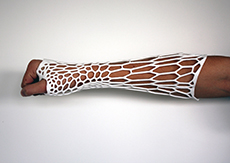
School of Design graduate Jake Evill has won the New Zealand section of the James Dyson Award with his Cortex Cast design.
Jake's design will now progress to the international competition in November. More information about the James Dyson Award can be found on the award website.
The following article about Jake's win was published by the New Zealand Herald online on August 22.
Kiwi's cast wins major design prize
The days of using a ruler to scratch beneath a plaster cast may be over, thanks to this year's winning invention in the New Zealand leg of the James Dyson Award, a global product design competition.
The winning design is a lightweight, no-itch nylon cast for broken bones, designed to replace the traditional plaster cast.
The 21-year-old designer, Jake Evill, was inspired after the frustration of wearing a cast when he broke his hand.
"Wrapping a broken or fractured arm in two kilos of clunky, soon to be smelly and itchy, plaster in this day seemed archaic to me,'' Mr Evill said.
His radical solution involved using data from both an X-ray and a 3D scan of the patient's fracture to create a custom-made cast.
The cast, named Cortex, is then printed using a 3D printer, and creates a snug, breathable fit.
The spiderweb-like membrane means the waterproof cast is well ventilated, and printed reinforcements mean the cast is strongest where the bone is broken.
Head judge David Lovegrove said the judges were unanimous in their decision, and the design embodied what the awards were all about.
"It has been the toughest judging year yet, though Cortex came out marginally ahead due to its global reach in improving many people's lives,'' he said.
The design may provide a real revolution in the way broken bones are treated, Mr Lovegrove said.
"Cortex is the re-imagining of the traditional plaster cast. It is a quite different take on what digital manufacturing can offer and could well change the way broken bones are treated in the future. It offers people with broken bones real benefits in terms of weight, comfort and convenience.''
As part of the prize package, Mr Evill has won a trip to the London Design Festival with $3,000 in travelling expenses and accommodation. He will meet key members of the British design community.
Ten New Zealand entries, including Cortex and the two national finalists, will progress to the international James Dyson Award competition and could win the equivalent of NZ$73,000 to help commercialise their ideas.
School of Design gets behind international conference
4 September
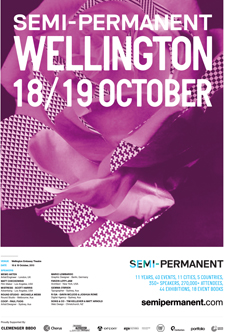
Victoria University of Wellington’s School of Design, in partnership with STUDIO (The Faculty of Architecture and Design student representative group) and the Computer Graphics Programme, is sponsoring the 2013 Semi-Permanent festival to be held in Wellington in October.
A creative platform highlighting the best in contemporary art and design—from graphic design, film, art, illustration, web design, photography, visual effects, animation, graffiti, motion graphics and more—Semi-Permanent is one of the largest events of its type in Australasia.
In addition to an exciting roster of international speakers, the event encompasses exhibitions, competitions, workshops and parties.
With annual conferences hosted in Sydney, Melbourne, Auckland, and Brisbane, plus events in Los Angeles, Portland, New York, London, Perth, Hong Kong and Stockholm, Semi-Permanent is a truly global platform.
This year’s Wellington event will be held at the Embassy Theatre. The School of Design and STUDIO are collaborating with Semi-Permanent organisers to develop a number of hands-on workshops that will allow students to engage with new methods of creative exploration.
“Semi-Permanent is a great opportunity for architecture and design students to get in contact with key figures from their fields and their wider interests,” says Margaret Petty, Head of the School of Design.
Zach Challies, president of STUDIO, looks forward to the opportunities the weekend will provide.
“The workshops are an invaluable tool for expanding and improving the skill sets and methods of the students who attend them. The conference itself will be a blast, as will exploring Wellington to visit the installations created by the conference speakers,” he says.
For more information
International blog success for School of Design
23 August
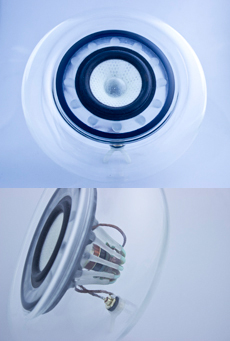
Work by students from Victoria University‘s School of Design is gaining international exposure through design blogs, some with the number of people viewing the work in the millions.
Over the past few months, international blogs including dezeen, mocoloco and designboom have published 3D printed objects created by third-year design students.
Industrial Design student Simon Ellison has had his design featured on the prestigious design blog designboom. He submitted a piece about his 'expose‘ 3D printed desktop speakers, which was shared for thousands of followers to read.
For a student, submitting to these kinds of blogs it is probably the simplest way to gain worldwide exposure—it can lead to offers of further publication in magazines, web pages or academic papers, all of which help to get our names out in the community, says Simon.
Publication is a way in which we can prove ourselves as well as providing a base layer to our work. If a future employer asks what we have in our portfolio, chances are it will have appeared on a blog, and they will have seen it or been told about it.
In addition to featuring on international blogs and social media sites, a 3D printed cast designed by Media Design student Jake Evill gained huge mainstream media attention, including an article in The New York Daily News. Jake‘s design also appeared in Forbes online.
Ross Stevens, Senior Lecturer of Industrial Design, says as a student this kind of exposure is invaluable for employment prospects after graduation.
Other design students recently featured:
Ella Bates-Hermans, Stalk. Speakers
Jack Huston, Eclipse speaker
Joe Levy, SpoolStool
Annabelle Nichols, Stylish Cycle Safety
Casey Lin, Timbre Timber
Jack Redpath, Lone
Earl Stewart, XYZ shoe
Soyun Park, Edge rings
Pictured: Expose speakers by Simon Ellison
New cast design making waves online
5 July
School of Design student Jake Evill has created a 3D printed alternative to the traditional cast for fractured limbs.
Dubbed the Cortex Cast, Jake’s design is more lightweight, breathable and hygienic than the current fibreglass cast being used, while still providing the same support for the healing process.
Jake’s design has been making waves over the internet lately, with features on well-known sites and design blogs such as ABC news, lostateminor.com and mashable.com.
The following article appeared on Stuff on Friday 5 July 2013
'Heroic' act spurs new cast tech
The scratchy, sweaty plaster cast could soon be a thing of the past, as a Victoria University graduate's sleek clip-on alternative gains international acclaim.
After being picked up by many online tech and design sites, Jake Evill's lightweight cast looks so good people have volunteered to fracture their wrists to try it out.
The fracture brace was called Cortex, and used 3D printing technology to follow the contours of the arm and provide support where the wrist needed it.
Cortex was born out of necessity after the architecture and design student conveniently broke his hand in a "heroic incident" during a fight one weekend.
"Being my first experience of wearing a plaster cast; I was surprised by just how non-user friendly those cumbersome things are," he said.
"Wrapping an arm in two kilos of clunky, soon to be smelly and itchy, plaster in this day and age seemed somewhat archaic to me."
He said there had to be some other way of supporting fractures, and went about designing a new option.
The cast, though still a prototype, would be washable, ventilated, and recyclable.
He started by researching the structure of the bone, which gave him inspiration for the lattice shape of the Cortex.
"As usual, nature has the best answers," he said.
"This natural shape embodied the qualities of being strong whilst light just like the bone it is protecting within."
He said after centuries of splints and plaster casts that had been the "bane of millions of children, adults and the aged alike", he could bring fracture support into the 21st century.
"The Cortex exoskeletal cast provides a highly technical and trauma zone localised support system that is fully ventilated, super light, shower friendly, hygienic, recyclable and stylish," he wrote on his website.
Patients would have their fracture X-rayed and the injured limb 3D-scanned.
A computer would determine the pattern and structure of the cast, with denser material around the fractured area of the bone to give more support.
After he had modelled the cast, it was sent to a factory in the Netherlands and printed in nylon plastic. It cost $US85 (NZ$105).
The cast would typically be 3 millimetres-thick and under 500 grams.
He said he still had a lot of work to do on the cast, and he was looking for partners to work with to make it a commercial reality.
Though it was still early days, the project had taken on a life of its own because of the "phenomenal interest" it generated, Evill said.
Victoria and Weta Digital power growth in Wellington
5 June
A new PhD scholarship in computer graphics at Victoria University, established by Weta Digital, will strengthen the drive by the two organisations to develop graduates who can power growth in Wellington’s digital industries.
The Weta scholarship, which covers PhD fees for three years and offers an annual $25,000 stipend, is also expected to provide opportunities for the successful recipient to work on research projects at and with Weta Digital.
Professor Neil Quigley, Deputy Vice-Chancellor (Research), says the PhD scholarship is both an exciting opportunity for an individual and an excellent example of the benefits of universities and industry working together.
“Input from Weta Digital, an international leader in its field, helps ensure that the computer graphics programme that we offer is not only academically challenging, but also relevant to what industry needs.”
Weta Digital’s Chief Technology Officer, Sebastian Sylwan, says the PhD scholarship is part of Weta’s commitment to building a strong eco-system in the capital’s entertainment and digital industries.
“For anyone looking for a university where they will be supported to carry out leading-edge Computer Graphics research at the PhD level, a driving factor is the relevance and applicability of the research itself.
“This scholarship will allow someone to do high quality research and have a connection to an international leader in computer graphics.”
Victoria’s computer graphics programme is unique in Australasia in the way it blends computer science and design.
The content is also unique with students investigating a combination of technical and visual innovation that is ideally suited to the needs of New Zealand’s entertainment and digital technologies industries.
Weta Digital, together with other technology companies, has played a key role in developing the specialisation at Victoria, which is now in its second year. To initiate the programme, in 2011, Weta Digital organised a lecture series which brought top computer graphics researchers from leading research labs worldwide to speak at Victoria.
Courses in the computer graphics programme have been taught by staff from Weta Digital and PikPok (formerly Sidhe Interactive).
Computer graphics students have had feedback from staff at Weta Digital about their projects and Weta Digital expects to hire graduates from the programme. PikPok and Unlimited Realities, another digital industry technology leader, are also expected to consider graduates from the programme.
The successful applicant for the scholarship will be supervised by staff at Victoria University and will report regularly to Weta Digital.
Applications for the scholarship are open. To find out more, visit:
fis website.
Visit, computergraphics for more on Victoria’s computer graphics programme.
Victoria Design School representation at the Maketorium
24 April
Several of Victoria's Design School student projects are being exhibited this weekend at Te Papa in the Makertorium – a showcase of Kiwi ingenuity. Creators, tinkerers and inventors from all over the country are heading to the National Museum to participate in the event.

Projects on display include:
- SketchChair from Diatom studio (Tiago Rorke and co.)
- A live audio visual installation projection by Oliver Ellmers
- The Pinokio Lamp by Shanshan Zhou, Adam Ben-Dror and Joss Doggett
- Pablo the People-friendly Triptopus by Ian Loh and Zhou Fang
- The Radiant Skirt By Maurizio Frances
The Makertorium will also feature work from the D.R.E.A.M Lab (Design + Research + Education into Additive Manufacturing)
The D.R.E.A.M collective is a collaboration of design professionals, lecturers and students at Victoria University’s School of Design. They combine the MDI (Master of Design Innovation) and Lecturer Research into emerging manufacturing technologies to expand and progress the way we design.
The Makertorium
10am to 6pm
Saturday 27th April 2013
Te Papa
Image: Pablo, a wearable technology project by Ian Loh and Zhou Fang
Victoria students launch summer projects
8 March
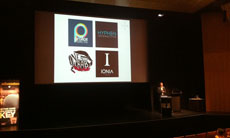
Congratulations to Victoria School of Design, School of Engineering and Computer Science, and School of Marketing students for a sucessful launch of their Summer Gaming Boot Camp projects last night at Te Papa's Soundings Theatre.
The multi-disciplinary student teams, supervised by School of Design lecturer Kah Chan, worked with Creative HQ, VicLink and Clemenger BBDO over the summer to develop, build and bring games to the market following a start up model. The event was well attended by representatives of Wellington's creative and business communities, as well as from VicLink and Creative HQ.
Victoria MDI student features on 3 News 'Tech Bytes'
4 March

MDI student Byron Mallett developed an interactive, generative sound installation titled 'Sonoromancer'.
Sonoromancer is a Kinect powered MIDI interface which uses a smoke fluid system powered by the body of the user in order to generate musical data.
3 News' TelstraClear Tech Bytes took a look at the computer programme that turns movement into music.
Pinokio Gets Staff Pick on Vimeo
28 February
Pinokio, an animatronic project made by Victoria studetns Shanshan Zhou, Adam Ben-Dor and Joss Doggett, was selected by the Vimeo team for their section 'Staff Picks'.
Pinokio is an exploration into the expressive and behavioural potentials of robotic computing and was created in the course Media Design 251 - Physical Computing.
Watch the video.
Internet award for Tardigotchi
22 February
Tardigotchi, the digital pet developed by Victoria University researchers has been announced as first prize winner in the Postscapes.com Internet of Things Award (Best Networked Piece of Art Category). Tardigotchi, a combination living organism and virtual avatar pet, has won several awards previously, and was created by Doug Easterly, Senior Lecturer in Media Design from Victoria University, Matt Kenyon from Penn State University, and graduate from Victoria’s Industrial Design programme Tiago Rorke.
An explanation of Tardigotchi and how it works can be found on the Tardigotchi website.
